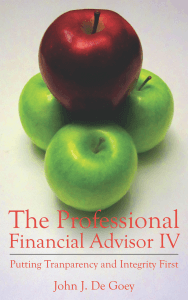How mutual fund fees work
What investors pay —and what advisors earn
Advertisement
What investors pay —and what advisors earn
 (Excerpted from The Professional Financial Advisor IV by John De Goey)
Over the past several years, I’ve spoken to representatives at a number of advisory firms about their philosophies so I could get a sense of their values and corporate culture. My sense is that compensation models can go a long way in explaining (or at least predicting) belief systems. Companies will say their advisors can work using either transactional or buy-and-hold philosophies. Either way, there’s room. They say you can be a comprehensive planner or a simple investment specialist. Either way, there’s room for that too. The advisors can be commission-based or fee-based. Either way, they would be welcomed.
(Excerpted from The Professional Financial Advisor IV by John De Goey)
Over the past several years, I’ve spoken to representatives at a number of advisory firms about their philosophies so I could get a sense of their values and corporate culture. My sense is that compensation models can go a long way in explaining (or at least predicting) belief systems. Companies will say their advisors can work using either transactional or buy-and-hold philosophies. Either way, there’s room. They say you can be a comprehensive planner or a simple investment specialist. Either way, there’s room for that too. The advisors can be commission-based or fee-based. Either way, they would be welcomed.
 We should explore and discuss differences of opinion rationally. Over the past few generations, we’ve seen a few hotly contested societal debates on civil rights issues such as same-sex marriage, universal suffrage, and racial integration. There have also been heated debates regarding science and technology. Ongoing debates of this kind include topics such as climate change and renewable energy. Perhaps the debate regarding the appropriateness of embedded compensation is the financial services debate of our generation. One thing to note about these kinds of debates is that a generation or two after they occur, people generally look back and marvel at the fact that there were actually people out there resisting change. For example, the history books have not been kind to those who favoured apartheid.
Let’s say a client is fully invested in a mutual fund portfolio with an average management expense ratio (MER) of 2.54%. Remember that an MER is the annual cost of owning the fund and that the results you get are reported after those charges have been deducted from the investor’s performance.
The cost (MER) on an A-class fund might break down like this:
We should explore and discuss differences of opinion rationally. Over the past few generations, we’ve seen a few hotly contested societal debates on civil rights issues such as same-sex marriage, universal suffrage, and racial integration. There have also been heated debates regarding science and technology. Ongoing debates of this kind include topics such as climate change and renewable energy. Perhaps the debate regarding the appropriateness of embedded compensation is the financial services debate of our generation. One thing to note about these kinds of debates is that a generation or two after they occur, people generally look back and marvel at the fact that there were actually people out there resisting change. For example, the history books have not been kind to those who favoured apartheid.
Let’s say a client is fully invested in a mutual fund portfolio with an average management expense ratio (MER) of 2.54%. Remember that an MER is the annual cost of owning the fund and that the results you get are reported after those charges have been deducted from the investor’s performance.
The cost (MER) on an A-class fund might break down like this:
| Product overhead (administration): | 0.25% |
| Fund manager charges (including profit): | 1.00% |
| Trailing commission (split between advisor and firm): | 1.00% |
| Total: | 2.25% |
Currently, there are three primary ways that an advisor selling mutual funds gets paid: 1) a deferred sales charge (DSC), 2) front end (FE) 0%, or 3) separately using an F-class version of the fund. We need to recognize that investors are buying the same fund with different compensation structures. The underlying investments, manager, sponsor, objectives, and other major attributes are the same. The only difference is how the client is billed and, as a result, how the advisor and their firm are paid. Deferred Sales Charge (DSC) The letters “DSC” still appear on many client statements, and when I see them, I ask would-be clients if they know what those letters mean. Most do not. A deferred sales charge (DSC) is commonly referred to as a “back-end load.” For most stock-based mutual funds, it means the advisor and their firm get a 5.0% commission within a couple of days of the sale and an additional 0.5% annually (0.125% quarterly) for as long as the investor holds the account. The numbers are similar, but lower, on income funds. The investor now has a potential charge that can be worked off over time. Note that an investor can change from one fund to another in the same fund family at any time. Although some advisors charge up to 2.0% for this right, most do not charge anything provided clients do this infrequently. It should be noted that clients can always withdraw up to 10% invested annually with no penalties. The 10% number is not cumulative, however, so one cannot withdraw 0% one year and expect to be able to withdraw more than 10% the next year without penalty. When it comes to the 10% rule, the words “use it or lose it” apply. As you might imagine, mutual fund companies don’t like losing money. If they pay an advisor and their firm $5,000 (5.0% on a hypothetical $100,000 invested) in week one, they’re not going to be happy if you pull your money out in week three. In fact, they’d be out about $5,000. The charge is supposed to act as a disincentive to selling early. The actual amount charged drops over time, since fund companies can earn out their prepaid advisory costs in the form of ongoing fees over time. A DSC redemption schedule might look something like this: Year Charge 1 5.5% 2 5.0% 3 4.5% 4 4.0% 5 3.0% 6 2.0% 7 1.0% Thereafter No charge To put this in perspective, if you had $50,000 invested in a DSC fund and elected to redeem everything in year two, your charge would be $2,250 (5.0% of $50,000 less 10% that can be redeemed for free). From a disclosure perspective, this is a charge over and above the MER, but it is only incurred if there is a redemption of more than 10% in any given year prior to the schedule running its course.Related: Remember when fund managers were rock stars?
The people at Morningstar suspended their awards gala for 2016 on the grounds that they give many of the prizes to companies and funds based on subjective data, like “juried’ selections.To their credit, Morningstar did not want to “feed the beast” of mutual fund marketing departments any longer. This is an important development because advisors using DSC funds could be armed with annual award data to assist in the sales process. Until now, advisors could use the awards to justify redeeming existing funds (including those with outstanding DSC balances) in order to place the proceeds into this year’s winning funds, thereby earning a commission, starting the DSC period all over again for their valued clients, and possibly causing an avoidable capital gain. Front End (FE) 0% Front end (FE) 0% funds and DSC funds have identical MERs—typically a little under 2.5%. One thing that has become quite popular over the past decade or so is that advisors have been moving client assets from DSC to FE 0% once the DSC schedule (such as shown above) runs out and there are no transaction costs to the client to do so. Note that if this switch takes place in a traditional investment (i.e., non-registered) account, there could be tax consequences. The 0% part of the FE format is really just a matter of taste. Advisors usually charge nothing to invest money on a front-end (sometimes called “no load”) basis, but they are allowed to if they wish. Most do not charge to allow access to this format. Instead of getting a large commission up front, advisors and their firms get nothing up front but generally get more on an ongoing basis. Most stock funds pay a 1.0% annual trailing commission (0.25% quarterly) to advisors and their firms using the FE format and pay a 0.5% annual trailing commissions (0.125% quarterly) on income funds. The cost to the client is the exact same under both DSC and FE formats. Clients can sell FE funds at any time with no penalty. F-Class Think of them as FE funds with no trailers baked into the cost and no payment made to the advisor. In the example used above, an FE A-class fund that costs 2.53% would cost between 1.40% and 1.43% in an F-class format (stripping out both the 1% trailing commission while accounting for how the HST liability is managed). Since F-class funds pay advisors nothing, it is up to advisors who use F-class funds to bill their clients directly. Obviously, if the advisor billed in an identical format, the same 0.25% + HST would be billed every quarter. If you asked advisors to rate where their loyalty lies—with their employers and suppliers, their clients, or their own families—very few would place their employers and suppliers anywhere other than third place. So here’s the obvious win here for everyone except those who finish third in this little prioritization thought experiment: What if the advisor charged a little more, used products that cost a lot less, and then passed the net savings on to clients? How things are now: the client pays a ~2.5% MER, and the advisor’s firm gets 1.0% What-if scenario: the client pays a total of ~1.76% with products costing 0.4%, and the advisor’s firm getting 1.2% while charging $0.156 in HST (the HST is 13% of the 1.2%) In the what-if scenario, the client saves 0.74% less any tax inefficiency for HST. On $100,000, that’s $740 each and every year. That’s an annual saving for about one-third of total costs. The advisor, instead of being a “price taker” who gets paid only what suppliers will pay him, gets to earn a bit more (good advice costs money, you know) and increases their revenue by 20% while doing what is right for the client, sourcing out cheaper products, and passing along the lion’s share of the savings. That’s a clear win/win situation! For fun, let’s imagine the account was a truly large one—say, $1 million. For starters, the advisor would likely be delighted to work for 1.0%. Adding on the HST and an additional 0.4% product cost, we’re now saving the client about 1.0%. For those of you keeping score at home, 1.0% of $1 million is $10,000. This is the amount the client would save every year for the rest of their life, unless, of course, the account grew over time. In that case, the client would save even more. This, of course, assumes everything else is the same and there is no incremental return added by the active management. Other things will not be the same but are about equally likely to be better or worse for both options.Related: Investment advice is not worth 35 times the DIY fee
Share this article Share on Facebook Share on Twitter Share on Linkedin Share on Reddit Share on Email